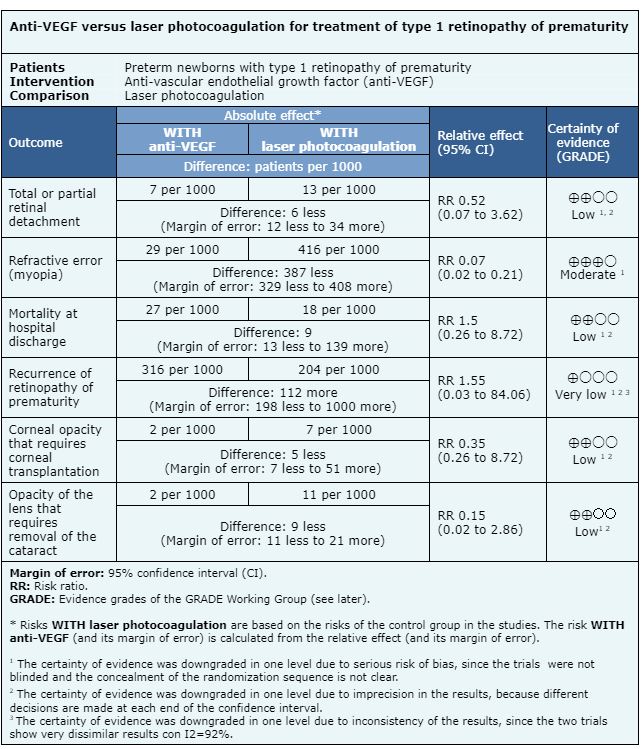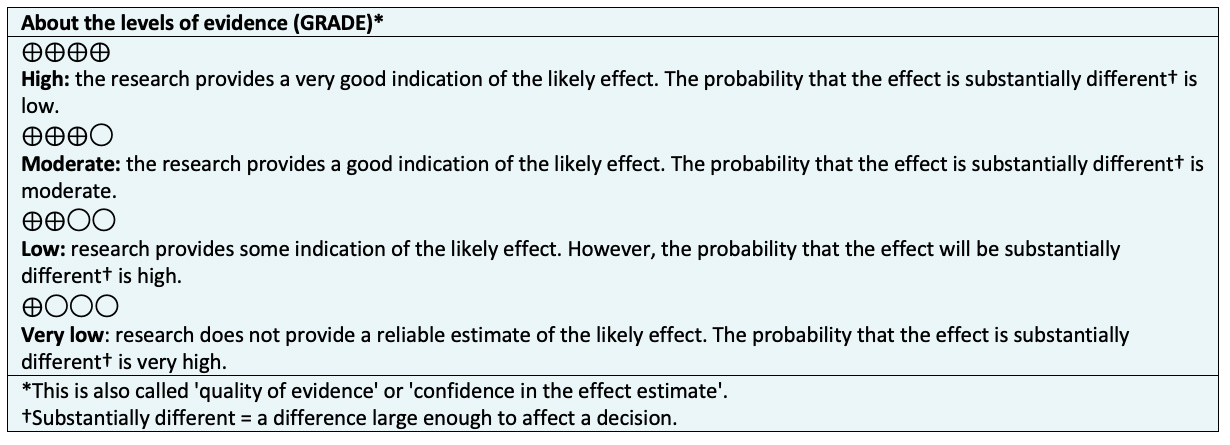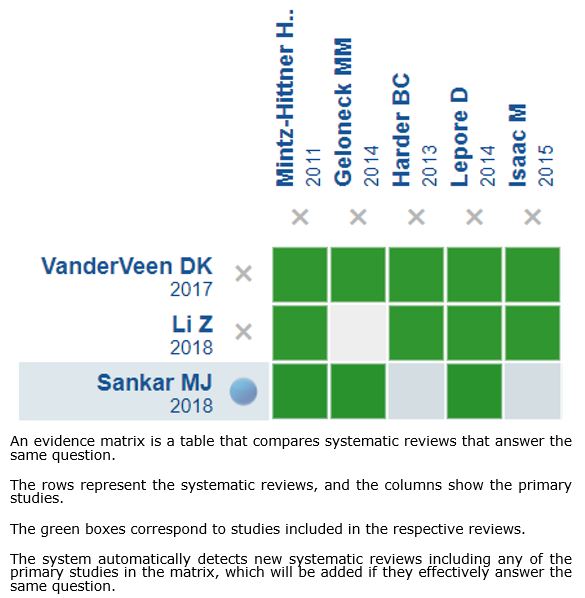Resúmenes Epistemonikos
← vista completaPublicado el 17 de enero de 2022 | http://doi.org/DOI 10.5867/medwave.2022.01.8507
Anti-factor del crecimiento vascular endotelial (anti-VEGF) comparado con fotocoagulación láser para el tratamiento de la retinopatía del prematuro tipo 1
Anti-vascular endothelial growth factor (VEGF) drugs compared to laser photocoagulation for treatment of type 1 retinopathy of prematurity
Abstract
INTRODUCTION Retinopathy of prematurity (ROP) is a condition that affects preterm infants, being the second leading cause of childhood blindness worldwide. The most commonly used treatments are cryotherapy or laser photocoagulation, but over the last few years, anti-vascular endothelial growth factor (anti-VEGF) drugs have gradually gained more adherents, mainly in the treatment of patients with type 1 retinopathy of prematurity (ET- ROP) Therefore, it is important to summarize the existing evidence to evaluate the efficacy and safety of anti-VEGF drugs in type 1 retinopathy of prematurity.
METHODS We searched in Epistemonikos, the largest database of systematic reviews in health, which is maintained by screening multiple information sources, including MEDLINE, EMBASE, Cochrane, among others. We extracted data from the systematic reviews, reanalyzed data of primary studies, conducted a meta-analysis and generated a summary of findings table using the GRADE approach.
RESULTS AND CONCLUSIONS We identified six systematic reviews including 15 studies overall, of which five were randomized trials. We conclude that the use of anti-VEGF compared to laser photocoagulation, probably reduces the risk of refractive errors. On the other hand, the use of anti-VEGF may result in little or no difference in the mortality at hospital discharge, lens or corneal opacity requiring surgery, and complete or partial retinal detachment, but the certainty of the evidence is low. Finally, it is not possible to clearly establish whether anti-VEGF compared with laser photocoagulation, increases the recurrence of retinopathy of prematurity, because the certainty of the existing evidence has been assessed as very low.
Problem
Retinopathy of prematurity (ROP) is a vasoproliferative disorder of the retina that affects preterm newborns (PTNB) resulting in the second cause of childhood blindness in the world. Ablation of the avascular retina, with cryotherapy or laser photocoagulation has been considered useful and effective treatments for retinopathy of prematurity [1] [2].
The role and association of vascular endothelial growth factor (VEGF) in the pathogenesis of retinopathy of prematurity has been studied extensively. It has been found that the retinal neovascularization that causes the traction ultimately leading to retinal detachment is mainly due to the development and effect of vascular endothelial growth factor (VEGF) [3], [4], [5]. Given the above, the use of intravitreal anti-VEGF agents has gradually gained popularity, and has even been recommended by some ophthalmologists as first-line therapy to treat aggressive posterior retinopathy of prematurity and zone I disease. The objective of this summary is to evaluate the efficacy and safety of anti-VEGF drugs as monotherapy in preterm infants with type 1 retinopathy of prematurity compared to laser photocoagulation therapy.
Methods
We searched in Epistemonikos, the largest database of systematic reviews in health, which is maintained by screening multiple information sources, including MEDLINE, EMBASE, Cochrane, among others, to identify systematic reviews and their included primary studies. We extracted data from the identified reviews and reanalyzed data from primary studies included in those reviews. With this information, we generated a structured summary denominated FRISBEE (Friendly Summary of Body of Evidence using Epistemonikos) using a pre-established format, which includes key messages, a summary of the body of evidence (presented as an evidence matrix in Epistemonikos), meta-analysis of the total of studies when it is possible, a summary of findings table following the GRADE approach and a table of other considerations for decision-making.
|
Key messages
|
About the body of evidence for this question
|
What is the evidence. |
The use of anti-VEGF compared to laser photocoagulation therapy probably reduces the risk of refractive errors .The use of anti-VEGF compared to laser photocoagulation therapy may make little or no difference in terms of treatment safety, whether in hospital discharge mortality, opacity of the lens or cornea that requires surgery and in partial or complete retinal detachment (certainty of low evidence).We are uncertain whether anti-VEGF compared to laser photocoagulation therapy reduces the recurrence of retinopathy of prematurity, as the certainty of the evidence has been assessed as very low. |
|
What type of patients did the studies include? * |
All trials included preterm infants with type 1 retinopathy of prematurity [13], [15], [19], [25], [29]. |
|
What type of interventions did the studies include? * |
All trials compared anti-VEGF therapy versus laser photocoagulation therapy (standard treatment) [13], [15], [19], [25], [29].The anti-VEGF used were bevacizumab in four trials [13], [15], [25], [27] and ranibizumab in one trial [19]. |
|
What type of outcomes did they measure |
The trials reported multiple outcomes, which were grouped by systematic reviews as follows:
The average follow-up of the trials was six months with a range between eight weeks and two years [13], [15], [19], [25], [29]. |
*Information on primary studies is extracted from the identified systematic reviews, not directly from the studies unless otherwise specified.
Summary of results
The information on the effects of anti-VEGF drugs is based on five randomized trials that include premature patients with type 1 retinopathy of prematurity [13], [15], [19], [25], [27]. Two trials measured the outcome recurrence of retinopathy of prematurity (193 patients) [13], [19]. Two trials measured the outcome mortality at hospital discharge (229 patients) [13], [27]. Four trials measured the outcome total or partial retinal detachment (393 patients) [13], [15], [19], [27]. Three trials measured the outcome opacity of the lens (cataract) that requires removal (544 patients) [13], [19], [27]. One trial evaluated the outcome corneal opacity requiring corneal transplantation (286 patients) [13]. One trial measured the outcome refractive error (myopia) (211 patients) [13].
The summary of the results is as follows:
- The use of anti-VEGF drugs compared to laser photocoagulation therapy may make little or no difference in total or partial retinal detachment (low certainty evidence).
- The use of anti-VEGF drugs compared to laser photocoagulation therapy probably reduces the risk of refractive errors.
- The use of anti-VEGF drugs compared to laser photocoagulation therapy may make little or no difference in mortality at hospital discharge (low certainty evidence).
- We are uncertain whether anti-VEGF drugs compared to laser photocoagulation therapy reduces the recurrence of retinopathy of prematurity, as the certainty of the evidence has been assessed as very low.
- The use of anti-VEGF drugs compared to laser photocoagulation therapy may make little or no difference in the generation of corneal opacities that require corneal transplantation (low certainty evidence).
- The use of anti-VEGF drugs compared to laser photocoagulation therapy may make little or no difference in the generation of lens opacities that require cataract removal (low certainty evidence).

Follow the link to access the interactive version of this table (Interactive Summary of Findings - iSoF)

Other considerations for decision-making
| To whom this evidence applies and to whom it does not apply. |
|
|
About the outcomes included in this summary |
|
|
Harm/benefit balance and certainty in evidence |
|
|
Resource considerations |
|
|
What would patients and their doctors think about this intervention |
|
|
Differences between this summary and other sources |
|
|
Could this information change in the future? |
|
How we conducted this summary
We collected all the relevant evidence for this question and presented it in an evidence matrix using automated and collaborative methods.

Follow the link to access the interactive version: Anti-VEGF compared to laser photocoagulation for type 1 retinopathy of prematurity
Notes
If new systematic reviews on this topic are published after the publication of this abstract, a "new evidence" notification will be displayed at the top of the matrix. While the project provides regular updates of these abstracts, users are invited to comment on the Medwave website or contact the authors by e-mail if they believe evidence warrants an earlier update.
After creating an Epistemonikos account, by saving the matrices, you will receive automatic notifications whenever there is new evidence that potentially answers this question.
This article is part of the Epistemonikos evidence synthesis project. It is elaborated with a pre-established methodology, following rigorous methodological standards and an internal peer review process. Each of these articles corresponds to a summary, called FRISBEE (Friendly Summary of Body of Evidence using Epistemonikos), whose main objective is to synthesize the body of evidence of a specific question, in a friendly manner for physicians. The main resources are based on the Epistemonikos evidence matrix and the analysis of the result is based on the GRADE methodology. Further details of this FRISBEE elaboration method are described here.
The Epistemonikos Foundation is an organization that seeks to bring information closer to health decision-makers through the use of technologies. Its main source is the Epistemonikos database (www.epistemonikos.org).
Competing interest
The authors declare no competing interest.

